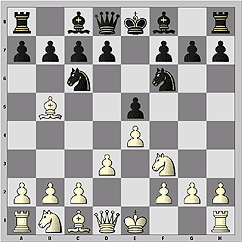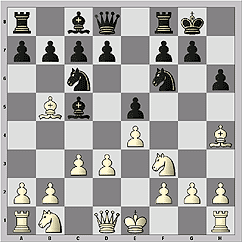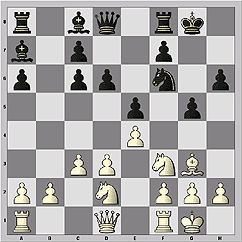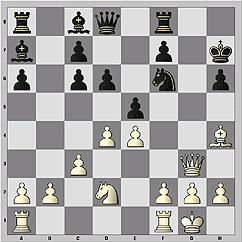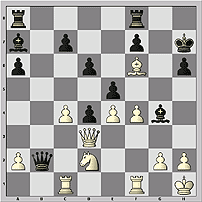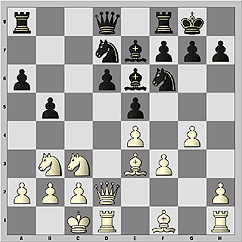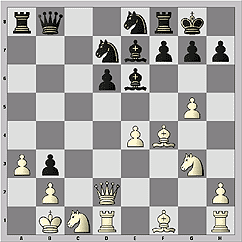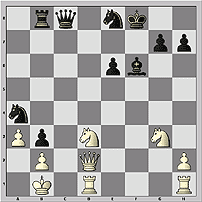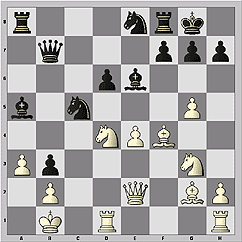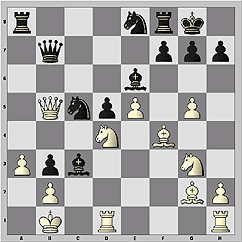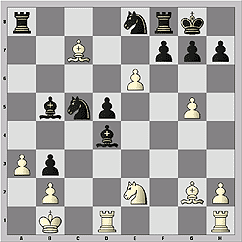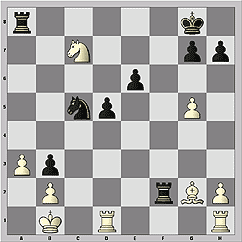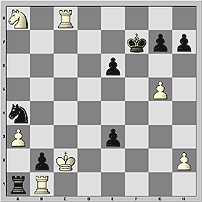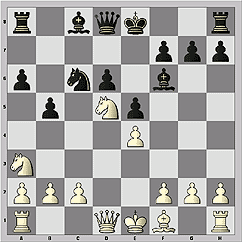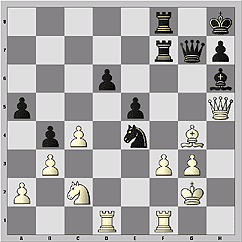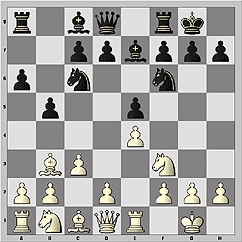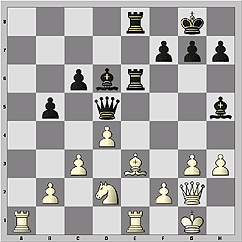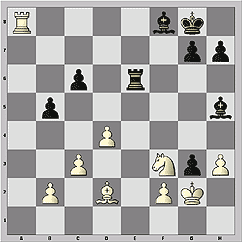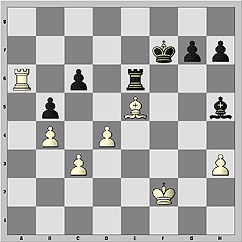 | Последние турниры |
Чемпионат России
СуперФинал

02.12.2006
Суперфинал чемпионата России проходит в Москве, в ЦДШ им. М.М.Ботвинника со 2 по 15 декабря при 12 участниках по круговой системе.
Крамник - Fritz

25.11.2006
С 25 ноября по 5 декабря в Бонне чемпион мира Владимир Крамник сыграет матч из 6 партий с программой Deep Fritz. В случае победы Крамник получит 1 миллион долларов, тем самым удвоив свой стартовый гонорар ($500000).
Мемориал Таля

5.11.2006
В Москве с 5 по 19 ноября проходил Мемориал Таля, в программе которого супертурнир 20-й категории и выдающийся по составу блицтурнир. Призовой фонд каждого состязания - 100.000 долларов.
Топалов - Крамник

23.09.2006
После того как "основное время" не выявило победителя (счет 6:6), 13 октября соперники сыграли 4 дополнительных поединка с укороченным контролем времени.
Томск. Высшая лига

2.09.2006
Со 2 по 11 сентября Томск принимает Высшую лигу чемпионата России 2006 года. В турнире участвуют 58 шахматистов - как получившие персональные приглашения, так и победившие в отборочных состязаниях.
Майнц

17.08.2006
В последние годы фестиваль в Майнце вслед за "Амбер-турниром" стал центром легких шахматных жанров. Наряду с массовыми ристалищами традиционно проходят чемпионские дуэли.
Россия - Китай

10.08.2006
С 10 по 20 августа в Китае проходит товарищеский матч сборных России и Китая. В нынешнем поединке как мужчины, так и женщины соревнуются на пяти досках по шевенингенской системе в два круга.
Все материалы
ChessPro

|
|

|
|
 |
By grandmaster
Sergey SHIPOV |
The Leader is Replaced |
Announcing his resignation from chess at the press-conference in Linares, Garry Kasparov told Anand: “Vishy, you are in charge now!”
The tired Leader left his Pack, the Council Rock emptied. Unfortunately, the appointed successor can’t be new Leader. Vishy obviously lacks energy . He has no punch, no speed.
In fact, the 9th Round of the WC saw the birth of a new Leader of the chess world. Anand abdicated. He wasn’t ready for a real struggle against Topalov in a complicated position. The draw was agreed immediately after the opening. This result opened the way to the Council Rock for his younger and more vigorous opponent.
The fight for the title shouldn’t overshadow another important phenomenon – Morozevich’s unexpected ascent! The most unpredictable grandmaster recovered after a poor start, gathered momentum and reeled off three wins in a row! It’s hardly feasible to catch up with Topalov, but scoring the second place in the final standing is a realistic task.
In the leader’s game there was an interesting start, but the plot didn’t have any logical outcome.
Ruy Lopez C65
Vishwanatan ANAND (IND) – Veselin TOPALOV (BUL)
1.e4 e5 2.Nf3 Nc6 3.Bb5 Nf6 4.d3! A good opening choice for the game you have to win. Tough slow play perfectly fits such a situation. The endgame in the Berlin Defense is too scrutinized. Besides Veselin is too good in this line with Black.
4...Bc5 5.c3 0–0 6.Bg5 h6 7.Bh4.
7...g5. Novelty. It’s a risky move! Black gets rid of the knight f6 pin, but weakens the fortress of his king. Only the one who has great self-confidence can play so boldly and aggressively in the game when draw and win are all the same for him. That is the champion’s nature! The game Shaughnessy – McMahon (Dublin 1992) saw 7...d6 8.Nbd2 Bd7 9.Nf1 Ne7 10.Bxd7 Nxd7 11.Bxe7 Qxe7 12.Ng3 g6 13.0–0 Bb6 14.d4 c6, and Black equalized.
8.Bg3.The piece sacrifice doesn’t promise White anything: 8.Nxg5 hxg5 9.Bxg5 and in addition to a calm 9...Be7 Black can also play 9...Bxf2+!? (9...d5 10.Qf3) 10.Kxf2 Nxe4+ 11.dxe4 Qxg5 and then d7-d6, with roughly equal chances.
8...d6 9.Nbd2 a6 10.Bxc6. Quickly played. Probably, this line was prepared at home. I like 10.Ba4 too. After the center opens up White will need the light-squared bishop.
10...bxc6 11.0–0 Ba7. This moment seems mysterious to me after the game.
12.d4!? Vishy made this important decision very quickly! He could not miss Black’s logical response. What did he hope for? What were his intentions? His ensuing actions gave no response to this question.
12...g4! 13.Bh4. Knight sacrifice suggests itself. Pawn sacrifice also deserved attention – 13.Nh4!? exd4 (otherwise there was no point in g5-g4) 14.cxd4 Bxd4 15.Qc1! – in fact, it’s a double blow on c6 and h6. However, 13.Bh4 looks more like a matter-of-principle move to me.
13...gxf3 14.Qxf3 (an attempt to bring the rook into play - 14.Re1 – can be parried with 14…Bg4!) 14...Kg7. The f6-knight needs constant care from more valuable black pieces.
15.Qg3+ Kh7. The Indian grandmaster thought about half an hour here. Unfortunately, the outcome of his internal struggle wasn’t in chess favor.
16.Qf3?! Anand can continue the battle in this game and in the tournament with 16.Qd3! with the idea of f2-f4 breakthrough. Of course White runs some risk, being down a piece. Those who take no risk drink no champagne! But what was the risk for Anand? What’s the difference – will he finish the event with an even score or with a small plus? And after a win he got real chances to win a world title....
This position is so complicated that I see no point in analyzing it now! Black also runs risks as his king is vulnerable. It’s absolutely clear that Anand must have played this way. And I’m sure that Topalov will never agree to a draw in such a position. He is not of the same kidney! Topalov never hide from interesting and promising complications.
Just for information I will point out several interesting lines after the best 16.Qd3: 16...c5 17.f4 cxd4 18.c4! (weaker is 18.Kh1 dxc3 19.bxc3 Rg8! and Rg8-g4 threat makes White to win a piece back, heading to an inferior endgame – 20.fxe5 dxe5 21.Qxd8 Rxd8 22.Nb3 и т.д.) 18...Bg4 19.Kh1! (19.fxe5? Be2!) 19...Qb8 20.Bxf6 Qxb2 21.Rac1! (21.fxe5 Qc3!)... and Black finds himself in a deadlock.
Black’s bishops have no room to move, White plans to suppress Black with f4-f5, black king is still under fire. A retreat 21...Bd7 (21...Rae8 22.f5!) leads to a collapse in the center – 22.fxe5 etc.
It is only a sketch, an illustration! I’m sure that in a long analysis we’ll find some good ways for Black. But it’s not an easy task at the board under stare of your opponent and with the clock tickling!
16...Kg7 17.Qg3+. Draw.
The game of the main pursuer was much more interesting. Peter went through a dubious position, obtained some advantage but missed his opponent’s brilliant saving combination.
Sicilian Defense B90SVIDLER (RUS) – Rustam KASIMDZHANOV (UZB)
1.e4 c5 2.Nf3 d6 3.d4 cxd4 4.Nxd4 Nf6 5.Nc3 a6 6.f3 e5. Let me skip the opening. The theoretical tree spread out. There are the layers of ideas on every move. 7.Nb3 Be6 8.Be3 Be7 9.Qd2 0–0 10.0–0–0 Nbd7 11.g4 b5. The war broke out simultaneously on both wings.
12.g5 b4 13.Ne2 Ne8 (that is the price for the speed of attack. Black has to retreat his knight to a poor position) 14.Ng3 a5 15.Kb1 a4 16.Nc1 Qb8 17.f4! White can hope for success only after obtaining advantage in the center.
17...exf4 18.Bxf4 b3 19.cxb3 axb3 20.a3. Black was first to launch active operations, but White managed to repel the first waive of the onslaught. To resume the attack Black should bring his pieces into play. The b3-pawn creates prerequisites for various combinations, first of all a sacrifice on a3. Which piece will be sacrificed, you may ask? Any piece, including the queen! Check out the game and you will see…
20...Qb7. This move is an novelty. Frankly speaking, it is very hard to weight various moves in such a complicated play. The position requires deep and precise calculation which is beyond human capacities. In the following game Black played very remorsefully and in my opinion was very close to the victory.
20...Bd8!? 21.Nf5 Nc5 22.Qd4 Qc8 23.Bxd6 Nxe4! 24.Bxf8 Kxf8 25.Bd3 Nc5 26.Ng3 Bxg5 27.Bc4 Bf6 28.Bxe6 fxe6 29.Qb4 (29.Rhf1! Kg8 30.Qf2) 29...Rb8 30.Qd2 Na4 31.Nd3.
31...Nxb2 (better was 31...Bxb2! with the idea of 32.Nxb2 Nc3+ 33.Ka1 Qc5!–+) 32.Nxb2 Qc2+ (32...Qc5!?) 33.Qxc2 bxc2+ 34.Kxc2 Rxb2+ 35.Kd3 Rb3+ 36.Ke2 Rxa3 37.Rd7 Ra2+ 38.Kf3 Be7 39.Ne4 Ra3+ 40.Kg2, and draw was agreed (Anisimov – Loginov, St-Petersburg 2002).
21.Nce2! Bd8! 22.Nd4! (the domination in the center is the best defense against the opponent's threats and a good foundation for White's own attack) 22...Ba5 23.Qe2 Nc5 24.Bg2! Highlighting a bad position of the black queen. However, Rustam had no desire to recede…
24...Bc3! (this move deserved an exclamation mark not only for its strenghth but also for the creative impulse) 25.e5. I don’t think that it is the best way to open the center. First, note that Black’s gift can’t be accepted: 25.bxc3 Rxa3 26.Bc1 (26.Nb5 Bc4! 27.Qxc4 Ra1+ 28.Kb2 Ra2+ 29.Kb1 Qa6–+) 26...Ra2 27.Bb2 (27.e5 Qa7) 27...Na4 28.Rd2 Rxb2+! 29.Rxb2 Nxc3+ and White loses his queen. In the line 25.Nxe6 fxe6! (25...Nxe6? 26.e5) the combination 26.Bxd6 (26.Rhf1 Na4 27.Bc1 Be5) 26...Nxd6 27.e5 Qa6 28.Qxa6 (on 28.Rxd6 Black reacts with the queen sacrifice that promised above – 28...Qxa3!!–+) 28...Rxa6 29.Rxd6 Rxd6 30.exd6 Rf2! 31.bxc3 Rxg2 does not offer much. Black can play for a win with a draw in his hand as his knight goes to a4 whereas the rooks deliver checks to the white king. Probably more promising is 26.Rhf1!? Na4 27.Bc1 as Black has problems reinforcing his attack. Finally, a reserved prophylaxis 25.Bc1!? looks reasonable. In some lines White may strip the black king with g5-g6!
25...d5! (Black stabilized the center and now has time to bring his e8-knight into play) 26.Qb5?! Apparently, that is Svider’s idea. Indeed, the exchange of the queens favors White.
26...Qc7?! Bad reaction. The queen took up a wrong square. Much better was 26...Qa7! with the idea… you are right! Black is going to sacrifice the queen for a couple of pawns on a3. For example 27.Nc6? (27.Bc1 Nc7 28.Qe2 Bxd4 29.Rxd4 Ne4 30.Rb4; 27.Qe2) 27...Qxa3! 28.bxa3 Rxa3 29.Qxb3 (what else?) 29...Rxb3+ 30.Kc2 Nc7 and Black has a strong attack and an extra pawn. So what should White do after 26...Qa7? I failed to found a reasonable way to mount defense. The moves 27.Bc1 and 27.Qe2 have their own drawbacks. Black transfers the e8-knight to c7, and then sends his c5-knight to e4 or a4. In other worlds, he has a very powerful attack.
27.Nge2! (good consolidating move) 27...Bd7. This move brings up complications and leads … to a draw! The continuation 27...Bxd4 28.Nxd4 Rb8 29.Qc6 Qa7! keeping the queens on the board deserves attention.
28.e6! Bxb5 29.Bxc7 Bxd4
30.Nxd4 I was under impression that White had a winning position. However, the postmortem did not bear it out this evaluation. The following line did not change the situation: 30.exf7+ Rxf7 31.Nxd4 Nxc7 (after 31...Bd3+ 32.Rxd3! Nxd3 33.Bg3 Black faces some problems in the endgame, despite his extra exchange.) 32.Nxb5 Rf2! 33.Nxc7 Rxg2 and Black saves the game by analogy with the line that happened in the game.
White’s passers on the queenside will be a decisive factor in this position.
30...fxe6! First, it was just impossible to believe that Black really played this move in the game. All other continuation did not help.
31.Nxb5 Nxc7 32.Nxc7 Rf2! Only at this point the situation cleared up. Black launches the attack along the second rank and attains a draw. It is worth mentioning that Kasimdzhanov was in time scramble. Nevertheless, he did not lose composure and found this brilliant defense.
33.Nxa8 Na4! (Although White has two extra pieces he can’t protect his king; 33...Rxg2? 34.Nb6+–) 34.Rd3. Black must deliver the perpetual. Draw was agreed, as pushing for win is too dangerous for White – 34.Be4 dxe4 35.Ka1 Rxb2 36.Rd8+ Kf7 37.Rc8 (The perpetual does not work here) 37...Ra2+ 38.Kb1 Rb2+ 39.Kc1 Ra2! (but Black has other trumps) 40.Re1? (40.Kb1!=) 40...b2+ 41.Kc2 Ra1 42.Rb1 e3!
White can stop the black pawns only at the cost of material concessions. Draw.
In the encounter of two players from the middle part of the tournament standings the time trouble mistakes decided the outcome. Peter played better than Alexander, but he was too slow. He didn’t have enough time to take the situation under control at the critical moment of the game and lost almost winning position...
Sicilian Defense B33
Alexander MOROZEVICH (RUS) – Peter LEKO (HUN)
1.e4 c5 2.Nf3 Nc6 3.d4 cxd4 4.Nxd4 Nf6 5.Nc3 e5 6.Ndb5 d6. Leko held the ground twice in Sveshnikov Variation. As a proverb promises, for the third time there was no draw.
7.Bg5 a6 8.Na3 b5 9.Nd5 Be7 10.Bxf6 Bxf6.
A usual continuation here is 11.c3, that’s why Morozevich opted for 11.c4!? As it was expected, Alexander tries to play originally from the very beginning. However, only the 15th White’s move is a novelty.
11...b4 12.Nc2 Rb8 13.b3 Bg5 14.g3 0–0 15.h4 Novelty. It’s not only a new move, but the beginning of an interesting plan. The game Wittmann – Lenz (Austria 1991) saw simple 15.Bg2 Be6 16.0–0 Qd7 17.Qd3 Bd8 18.Rad1 g6 19.Kh1 Rb7 20.f4 with a bloody battle.
15...Bh6 16.Bh3 Be6! 17.Kf1 a5 18.Kg2 Rb7 19.Bf5!? That is Morozevich’s style. He provokes the opponent to start active operations.
19...Kh8 20.Qd3 Nb8! (masterful knight maneuver) 21.Rad1 Na6 22.Qf3 g6 23.Bh3 f5! Black’s strategy is more effective. 24.exf5 suggests itself, the queen is peering at the rook on b7.
24.h5!? (the move from a great optimist; in general, opening of the “h” file is one of the elements of White’s plan, but...) 24...fxe4 25.Qxe4 Nc5 26.Qe2 Bxd5+! 27.Rxd5 Rbf7 (White doesn’t have enough time to enjoy the fruits of his play) 28.Rf1. Black bishop and king take a long breath. After 28.hxg6? Rxf2+ 29.Qxf2 Rxf2+ 30.Kxf2 Qf6+ 31.Kg2 Qxg6 black queen bursts into White’s camp.
28...gxh5 29.Qxh5 Qf6 30.Bg4 (Being in severe time trouble Peter was accurate for a long time) 30...Ne4! 31.f3 Qg7! It looks like 32.Qh3! is better.
32.Rdd1?! Black is dazzled – there are too many promising possibilities. To find the best way and to focus on one line is not an easy thing to do in the time trouble!
32...Nf6. A march to nowhere. It’s unbelievable, but Black can sacrifice the knight here and continue the attack with slow play: 32...Nxg3!? 33.Kxg3 Rf6! – white queen position is too bad – 34.Qh3 (or 34.Kf2 Bf4 35.Qh4 e4! 36.Nd4 exf3 37.Rg1 Rh6 38.Bh5 Qe5 39.Rge1 Qxh5–/+) 34...Bf4+ 35.Kf2 Rh6 36.Bh5 e4 37.Rd4 Qe5 38.Rxe4 Qc5+ 39.Ke1 Rxh5 40.Qe6 Rhf5 – Black’s advantage is obvious.
Probably, 32...Nd2! 33.Rf2 Rf6 is even stronger. The idea is the same – to catch the white queen: 34.Qh3 Bg5 35.Bh5 (35.Rdxd2 Bxd2 36.Rxd2 Rh6 37.Bh5 Qg5–+) 35...Ne4 36.Rff1 Nc3 37.Rde1 (37.Ra1 Bf4 38.Kh2) 37...Bd2 38.Ra1 (the board is large, and still there is nowhere to escape) 38...Rg8 and White is unable to defend.
33.Qh3 Nxg4 34.Qxg4.
34...Qf6?! Leko overestimates his position. Peter goes too far in the quest for the victory. This move is bad from practical point of view, though it’s not losing yet. It was high time to subdue his pride.
34...Qxg4 35.fxg4 Rxf1 36.Rxf1 Rxf1 37.Kxf1 Kg7 38.Ke2 e4 39.Nd4 Kf6 led to an equal endgame as White can’t take Black poisonous pawn: 40.Nc6 Ke6 41.Nxa5? Kd7! – the catcher is caught himself. 42.c5 d5! doesn’t help.
35.Qe4 Bf4 36.Kf2! (36.gxf4? Qh4!) 36...Qh6! (the bishop’s retreat was psychologically unbearable) 37.gxf4 Rxf4 38.Rh1 Qg7 39.Qd5. Here, one step before the control move, Peter made a fatal flow.
39...e4? The correct line was 39...Rxf3+ 40.Qxf3 e4! 41.Qxf8+ Qxf8+ 42.Ke1 Qf3 43.Rf1 (43.Kd2 Qf4+!) 43...Qc3+ 44.Ke2 Qxc2+ 45.Rd2 Qc3 46.Rxd6 – White can’t win this position.
40.Rdg1! (Morozevich has enough time to reorganize his pieces and contaign Black’s attack) 40...Rxf3+ 41.Ke2 Rf2+ 42.Kd1 Qe5 43.Rh5! Rf1+ 44.Rxf1 Rxf1+ 45.Ke2 Qf4 46.Qd4+ Kg8.
47.Rg5+! Qxg5 48.Kxf1 Qc1+ 49.Ne1 Qf4+ 50.Kg1 Qg5+ 51.Ng2 Qc1+ 52.Kh2 Qh6+ 53.Kg3 Qg5+ 54.Kf2. There are no more checks. It’s well-known that the king interacts perfectly with the knight at a short distance.
Black resigns!
The game between outsiders was overshadowed by the other events of the day. Judit and Michael play by inertia. The only remaining task is not to lose again, to save the reputation. A draw was a logical outcome of their game. The position was roughly equal throughout the game.
Ruy Lopez C89
Judit POLGAR (HUN) – Michael ADAMS (ENG)
1.e4 e5 2.Nf3 Nc6 3.Bb5 a6 4.Ba4 Nf6 5.0–0 Be7 6.Re1 b5 7.Bb3 0–0 8.c3.
8...d5 9.exd5 Nxd5 10.Nxe5 Nxe5 11.Rxe5 c6 12.d4 Bd6 13.Re1 Qh4 14.g3 Qh3 15.Be3 Bg4 16.Qd3 Rae8 17.Nd2 Re6 18.a4 Qh5 19.axb5 axb5.
20.Qf1 Rfe8 21.Bxd5 Qxd5 22.h3 Bh5. In Leko – Kasimdzhanov (Linares 2005) game Black didn’t manage to equalize: 22...Bf5 23.Qg2 Qxg2+ 24.Kxg2 R6e7 25.b3 f6 26.Ra2 Be6 27.c4 Bb4 28.Rc1 Bf5 29.g4 Bd3 30.Nf1 Be4+ 31.Kg1 f5 32.Ng3 fxg4 33.Nxe4 Rxe4 34.hxg4 Rxg4+ 35.Kf1 Bd6 36.Ra6!, but the game ended in a draw also.
23.Qg2.
23...Qxg2+. Novelty. Gurevich,I-Benjamin,J/New York 1992 saw 23...f5 24.Qxd5 cxd5 25.Nf1 (25.Ra5!?) 25...f4 26.Bd2 Rxe1 27.Rxe1 Rxe1 28.Bxe1 Be2 29.Nh2 Kf7 30.Kg2 Kf6 31.f3 h5 32.g4 g6 33.Nf1 hxg4 34.hxg4 g5, and Black held the position.
24.Kxg2 f5 (even without queens Black has a strong pressure in the centre) 25.Nf3 f4 26.Bd2 fxg3 27.Rxe6 (27.fxg3? Re2+) 27...Rxe6 28.Ra8+ Bf8.
29.Ne5! Well-played. There was no point in trying to save the pawn. In the end let me amuse you with the following variation: 29.Kxg3? Rg6+ 30.Ng5 h6 31.Kh4 Bd1 32.Nh7! Kxh7 33.Rxf8 Rg2! 34.Rf7 – otherwise g7-g5 mating – 34...Kg8 35.Rf5 Bc2! 36.Re5 Kh7 37.Re7 Rxf2 and Black has a big plus in the endgame.
29...gxf2 30.Kxf2 Re8 31.Ra6 Bd6 (I would have tried to play for a win – 31...c5!?) 32.Bf4 Bxe5 33.Bxe5 Re6 34.b4 Kf7.
35.Ra7+ Re7 36.Rxe7+ Kxe7 37.Bxg7. Draw.
Standings after Round 9: 1. Topalov – 7,5 (this is a typical result for a winner of Swiss system tournament with players of different class including amateurs …); 2. Svidler – 5,5 (the gap is still too big, a suite should be closer to the king!); 3–4. Anand and Morozevich – 5 (Alexander has already caught up with the vanguard; it’s a pity that tournament is so short…); 5. Leko – 4 (everything is over for Peter; even if Leko finishes well, we can say that it was a bad tournament for him); 6. Kasimdzhanov – 3,5; 7. Adams – 3; 8. Polgar – 2,5.
|
|

